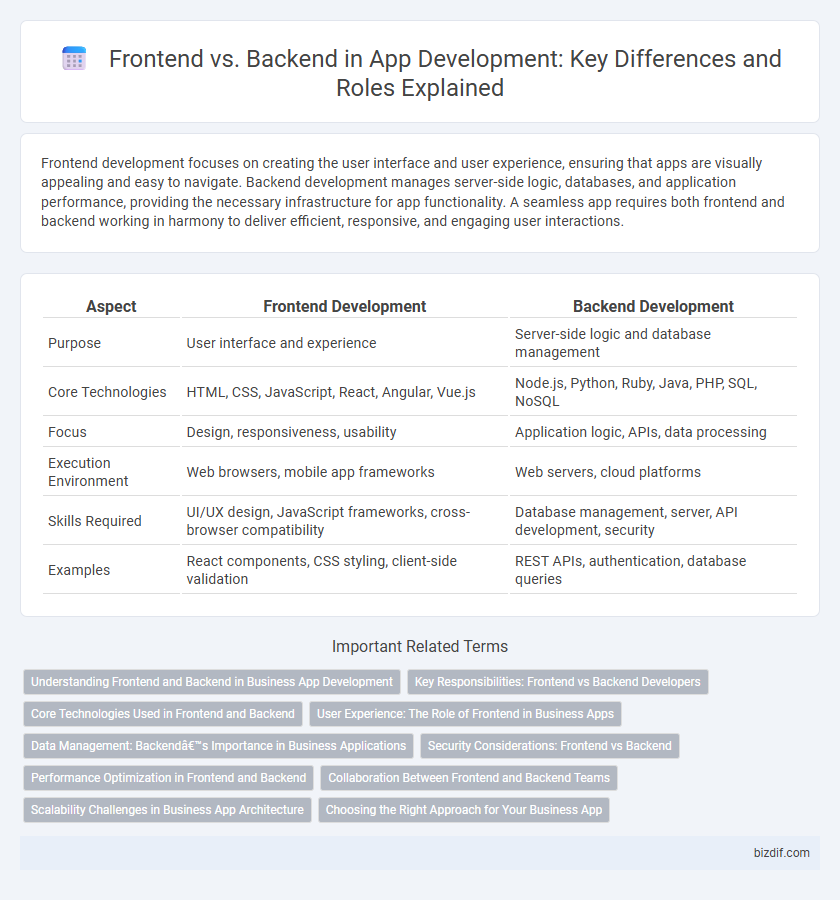Frontend development focuses on creating the user interface and user experience, ensuring that apps are visually appealing and easy to navigate. Backend development manages server-side logic, databases, and application performance, providing the necessary infrastructure for app functionality. A seamless app requires both frontend and backend working in harmony to deliver efficient, responsive, and engaging user interactions.
Table of Comparison
| Aspect | Frontend Development | Backend Development |
|---|---|---|
| Purpose | User interface and experience | Server-side logic and database management |
| Core Technologies | HTML, CSS, JavaScript, React, Angular, Vue.js | Node.js, Python, Ruby, Java, PHP, SQL, NoSQL |
| Focus | Design, responsiveness, usability | Application logic, APIs, data processing |
| Execution Environment | Web browsers, mobile app frameworks | Web servers, cloud platforms |
| Skills Required | UI/UX design, JavaScript frameworks, cross-browser compatibility | Database management, server, API development, security |
| Examples | React components, CSS styling, client-side validation | REST APIs, authentication, database queries |
Understanding Frontend and Backend in Business App Development
Frontend development in business apps focuses on creating user interfaces that enhance user experience through responsive design, intuitive navigation, and seamless interactivity. Backend development manages server-side logic, databases, and application integration to ensure data processing, security, and scalability. Together, effective frontend and backend collaboration drives robust, efficient business applications tailored to meet specific organizational needs.
Key Responsibilities: Frontend vs Backend Developers
Frontend developers focus on designing and implementing user interfaces, ensuring responsive layouts, and optimizing user experience across devices using technologies like HTML, CSS, and JavaScript frameworks such as React or Angular. Backend developers are responsible for server-side logic, database management, API development, and ensuring application scalability and security using programming languages like Python, Java, or Node.js. Collaboration between frontend and backend teams is essential for seamless integration of UI components with server-side functionalities and efficient data flow.
Core Technologies Used in Frontend and Backend
Frontend development primarily utilizes HTML, CSS, and JavaScript frameworks such as React, Angular, and Vue.js to create responsive and interactive user interfaces. Backend development relies on server-side languages like Node.js, Python, Ruby, Java, and databases such as MySQL, MongoDB, and PostgreSQL to manage data, authentication, and server logic. Both layers integrate APIs and cloud services like AWS or Azure to enable seamless communication and scalability.
User Experience: The Role of Frontend in Business Apps
Frontend development directly shapes user experience in business apps by ensuring intuitive interfaces, responsive design, and seamless navigation. This layer communicates with backend servers to retrieve and display data efficiently, making user interactions smooth and engaging. Optimizing frontend performance reduces load times and increases user satisfaction, driving higher engagement and business success.
Data Management: Backend’s Importance in Business Applications
Backend systems play a crucial role in data management by securely storing, processing, and retrieving business information through databases and server-side logic. This infrastructure ensures data integrity, scalability, and real-time synchronization critical to application performance and user experience. Efficient backend data management supports compliance with data privacy regulations and drives informed decision-making in business applications.
Security Considerations: Frontend vs Backend
Frontend security focuses on protecting user interfaces from cross-site scripting (XSS), input validation vulnerabilities, and ensuring secure data transmission through HTTPS and content security policies (CSP). Backend security emphasizes safeguarding databases and servers from SQL injection, unauthorized access, and ensuring robust authentication, authorization, and encryption mechanisms. Both layers must work together to create a seamless, secure app environment, with backend handling sensitive data securely while frontend defends against client-side exploits.
Performance Optimization in Frontend and Backend
Performance optimization in frontend development involves techniques like minimizing HTTP requests, leveraging browser caching, optimizing images, and employing lazy loading to enhance user experience and reduce load times. Backend performance optimization focuses on efficient database queries, server-side caching, load balancing, and asynchronous processing to ensure fast data retrieval and scalable application response. Both frontend and backend optimizations significantly contribute to overall application speed, reliability, and user satisfaction in app development.
Collaboration Between Frontend and Backend Teams
Effective collaboration between frontend and backend teams ensures seamless integration of user interface designs with server-side logic, enhancing overall application performance. Utilizing shared tools like API documentation platforms and version control systems streamlines communication and reduces development bottlenecks. Regular synchronization meetings foster alignment on technical requirements and accelerate problem-solving during app development.
Scalability Challenges in Business App Architecture
Scalability challenges in frontend development often stem from handling increased user interactions and rendering complex interfaces efficiently, requiring optimized state management and responsive design techniques. Backend scalability issues typically involve managing growing data loads, ensuring robust API performance, and maintaining database integrity under high traffic conditions. Effective business app architecture integrates microservices and horizontal scaling strategies to balance frontend responsiveness with backend processing power, enabling seamless growth.
Choosing the Right Approach for Your Business App
Choosing the right approach for your business app hinges on understanding the distinct roles of frontend and backend development; frontend focuses on user interface and experience, while backend manages server, database, and application logic. Prioritizing seamless integration between frontend technologies like React, Angular, or Vue.js and backend frameworks such as Node.js, Django, or Ruby on Rails ensures scalability and performance. Evaluating specific business needs, user interaction requirements, and data processing demands leads to an optimized development strategy that enhances functionality and user satisfaction.
Frontend vs Backend Infographic

 bizdif.com
bizdif.com